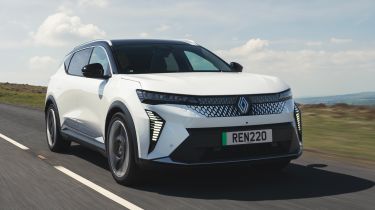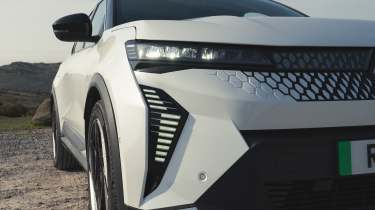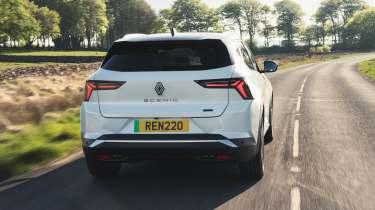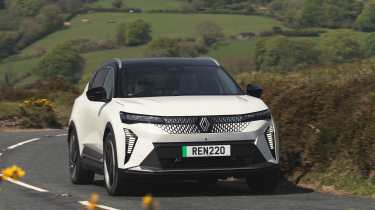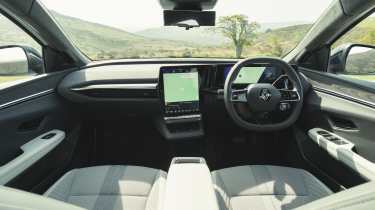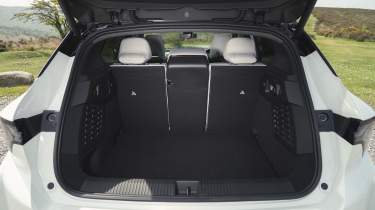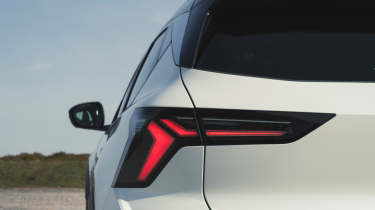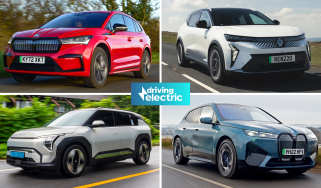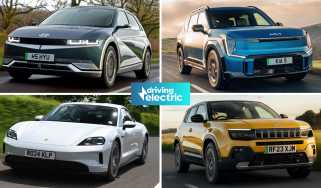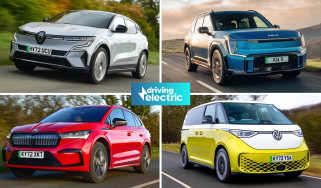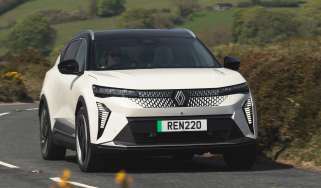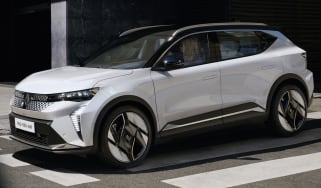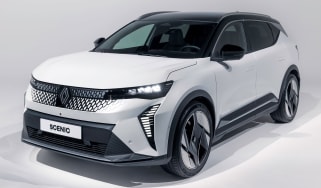Renault Scenic review
Renault has re-established itself as a titan of Europe’s family car sector; the Scenic offers range, tech and space, all at a reasonable price
Pros
- Class-leading range
- Strong tech offering
- Spacious interior
Cons
- Not much fun to drive
- High boot loading lip
- Renault customer satisfaction
Renault Scenic verdict
The Renault Scenic has been reborn as an SUV for the electric age, and the automotive industry may not have seen quite such a dramatic reinvention since the third-generation Mercedes A-Class launched in 2012. The all-electric Scenic has been thrown in at the deep end amongst a raft of established rivals, yet manages to swim to the forefront thanks to its superb electric range, strong refinement and slick tech offering.
If you’re after a sporty driving experience, or eye-watering performance, you won’t find it here – though we think Renault’s focus on refinement and comfort, along with the Scenic’s keen price, makes it an appealing car for electric family SUV buyers. We were supremely impressed by the smaller and cheaper electrified Megane hatchback, but several advancements mean that the more practical Scenic is an even more appealing proposition.
Details, specs and alternatives
Following the launch of its first EV, the ZOE supermini, it took Renault almost 10 years to come out with another electric car. That follow-up arrived in the form of a new electrified version of the long-running Megane hatchback - if we ignore the Twizy quadricycle and the very limited-run Fluence Z.E saloon. Now, only a few years on from the arrival of the Renault Megane E-Tech, we have its newer, bigger brother: the Renault Scenic E-Tech.
Forget the frumpy Scenic MPV of old, this latest model is a fashionable electric family SUV to rival the likes of the Hyundai Ioniq 5, Skoda Enyaq, Toyota bZ4X, Nissan Ariya and, of course, one of the best-selling electric cars on the market: the Tesla Model Y. Those with deeper pockets, or more generous company car allowances, may also be considering the BMW iX1, Audi Q4 e-tron or Volvo EX40.
The Renault Scenic has them all trumped in terms of electric range, though. There are two battery configurations available, a 60kWh battery returning up to 260 miles on a single charge, or an 87kWh battery that returns an official WLTP range of 379 miles – almost 50 miles more than the equivalent Tesla. The larger and more powerful 87kWh battery model produces 217bhp, meaning the Scenic’s electric motor can’t quite match the Model Y in terms of outright performance. That said, Renault says you only need to plug-in the Scenic for half-an-hour at a 100kW public rapid charger for over 200 miles of continued motorway driving.
The Scenic is available in three trim levels: Techno, Esprit Alpine and Iconic. Starting from just over £37,000 for the entry-level Techno trim, rising to around £41,000 with the larger battery, the Scenic is a bit of a bargain in the electric family SUV space – especially given the long range it offers. Standard equipment is strong, too, with even the base Renault Scenic Techno getting a slick dual-screen infotainment system (more on that later), LED headlights, climate control, heated front seats, a heated steering wheel, a wireless smartphone charger and a plethora of driver assistance features, such as blind spot monitoring, lane-keep assist, adaptive cruise control, front-and-rear parking sensors and a reversing camera.
If you’re a fan of Formula One, the sporty-looking Esprit Alpine model, inspired by Renault’s performance brand and F1 team, kicks off at around the £43,500 mark. This gets several styling accents in the signature Alpine blue, as well as a set of figure-hugging sports seats, a model-specific Alpine steering wheel and a set of 20-inch alloy wheels (Iconic cars get 19-inch alloys as standard).
Finally, there’s the top-spec Renault Scenic Iconic that starts from around £45,500. For your extra cash over the base Techno car you get 20-inch alloy wheels, as well as a Harman Kardon sound system, recycled fabric upholstery, a massaging driver’s seat, a digital rear-view mirror, an electrically frosting glass roof and 360-degree camera system. Ultimately, we think the base Techno represents the best value for money, although we do understand why you may be tempted by the extra goodies offered by the top-spec model.
Range, battery size & charging
| Range | Wallbox charge time | Rapid charge |
| 60kWh - 260 miles | 9.1hrs (0-100%, 7.4kW) | 32mins (15-80%, 130kW) |
| 87kWh - 379 miles | 13hrs (0-100%, 7.4kW) | 37mins (15-80%, 150kW) |
The Renault Scenic has two battery configurations available. The smaller battery has a usable 60kWh, which will give the car an electric range of up to 260 miles on a single charge. The larger battery has a usable 87kWh and is claimed to do 379 miles on a single charge. In comparison, a Tesla Model Y Long Range is capable of up to 331 miles before needing to be plugged-in, while a Hyundai Ioniq 5 has a maximum range of up to 315 miles.
As is the case with most electric cars, this figure is a best-case-scenario estimate. When we drove the Scenic with the 87kWh battery, we averaged 3.8 miles per kWh which would return an impressive real-world range of around 330 miles. This was after a three-hour drive at motorway speeds and with the air-conditioning on. In the winter months, the standard-fit heat pump on all models should help you get close to the claimed range, too.
As standard, the Renault Scenic comes with 130kWh DC rapid charging capability, uprated to 150kWh for cars fitted with the bigger battery. Renault says this is enough for a 15-80% top-up in around 37 minutes when connected to a fast enough public charger. Of course, using a home wallbox will take a lot longer – Renault quotes a full charge will take between 9 and 13 hours, battery size depending.
Running costs & insurance
Starting at just over £37,000 for the 60kWh battery pack model, the Renault Scenic is competitively priced for an electric family SUV – especially if you consider a Tesla Model Y RWD starts from just under £45,000 and offers a similar range. Even if you configure the Scenic with the larger 87kWh battery, prices start from just under £41,000, meaning you’ll still be saving around £4,000 over the base-level Tesla Model Y, or around £12,000 compared to the Tesla Model Y Long Range - the Renault can also travel around 50 miles further than the Model Y Long Range, too.
Insurance costs for battery powered cars are nearly always higher than for internal combustion powered cars, that being said, insurance prices for the Renault Scenic should be fairly reasonable. Scenic’s fitted with the 60kWh battery pack are placed in insurance group 28, while all cars specced with the bigger 87kWh battery are in insurance group 32.
All of the usual electric car benefits will apply to the Scenic, including rock-bottom 2% Benefit-in-Kind company car tax rates until 2025, with zero road tax (VED) to pay until the same year. With that being said, the Scenic’s large 87kWh battery pack means it might not be quite as cheap to charge as you might expect; a full charge at the average electricity rate of 30p per kilowatt-hour will set you back roughly £25, while the average rapid charging cost of 79p per kilowatt-hour means that a 10-80% charge will come to around £46 – cheaper than filling up a combustion SUV with petrol, but not exactly as inexpensive as many might anticipate.
Performance, motor & drive
| 0-62mph | Top speed | Driven wheels | Power |
| 60kWh - 8.6s | 93mph | Front | 168bhp |
| 87kWh - 7.9s | 105mph | Front | 217bhp |
Let’s make this clear straight off the bat: Renault has focussed on comfort and refinement rather than driving dynamics, so if you’re looking for a car which is fun to drive, you’d be better-off with key rivals like the Hyundai Ioniq 5, Skoda Enyaq or Kia EV6. As mentioned above, the Renault Scenic is available with a 60kWh battery with an electric motor producing 168bhp or a larger 87kWh battery model with an electric motor which produces 217bhp, with power going to the front wheels. Performance for the more powerful version is respectable, but 0-62mph takes a pretty unstimulating 7.9 seconds, down from 8.6 seconds for the 168bhp version.
Either option should be fast enough for most buyers, and with strong acceleration taking place between 0-30mph, the Scenic should feel nippy around town. Merging onto motorways and overtaking at higher speeds shouldn’t be too difficult, either.
Weighing in at roughly 1,800kg, the Renault Scenic might sound like a heavy car but it's towards the lighter end of the scale for an electric SUV. If you opt for the bigger battery, this will add an additional 96kg to the kerbweight, placing it around the middle of the pack when it comes to EVs of similar dimensions. Yet, many of the Scenic’s competitors manage to disguise their bulk better on a twisty road, despite this, the car does feel stable and predictable. The steering is well weighted at higher speeds, but there is a slight delay in the response to steering inputs, and there’s not a lot in the way of feedback.
The suspension setup is designed in such a way that it swallows up potholes and smooths out rough roads, making the Scenic a comfy car to get about in. Body roll through longer corners is minimal, but quick changes in direction can throw the car out of balance a little. Navigating tighter roads and urban environments is easy thanks to the Scenic’s light steering and tight 10.9-metre turning circle.
There are four levels of brake regeneration, ranging from one-pedal driving to no brake regeneration at all. That being said, when the regeneration system is turned down to its lowest setting, the brakes will feel spongy – we recommend setting the regeneration system at higher levels for more resistance, and therefore confidence, in the brake pedal. The regeneration system is smooth and the brakes don’t grab harshly when transitioning between braking and throttle inputs.
High levels of refinement mean the Renault is pretty quiet, too. Wind noise and tyre roar can become a tad intrusive when travelling at motorway speeds, but the ‘acoustic windows’ do a good job of dialling this out.
Interior, dashboard & infotainment
We previously gave the Renault Megane E-Tech an award for its Google-based infotainment system and the Scenic gets this same set-up, just with a larger 12.0-inch centre display and a 12.3-inch driver’s digital cockpit display. This, as you’d expect, benefits from things like Google Maps built-in, as well as smart EV route planning and battery preconditioning, meaning the battery should be at the right temperature when you come to recharge, allowing for the fastest speeds the charger can offer. Apple CarPlay can also be used if you’re an iPhone user.
Lots of the car's minor controls are located within the touchscreen, but we’re thankful that Renault has maintained a row of physical toggle switches and buttons at the bottom of the display, allowing you to easily adjust the climate control or use the heated seats without the need to go into different submenus. The infotainment system is simple to navigate and has no noticeable lag. We did, however, have one minor gripe regarding the ‘home’ button – having it fixed in one position would make the whole system much quicker to use.
Moving away from the tech offering, the Scenic’s interior has a high quality feel to it with a plethora of sustainable materials – you can’t get a Scenic with leather upholstery. Everything feels well-screwed together and is laid out where you expect it to be. The full-length glass ‘Solarbay’ panoramic sunroof helps the car stand out against its rivals and comes as standard on the range-topping Iconic trim level. The sunroof is split into segments that can transition between transparent and opaque thanks to liquid crystals, and can be adjusted using the built-in Google voice assistant, or the overhead controls. The cabin also felt light and airy thanks both to this roof and to the light grey and white interior colour scheme on our car.
Boot space, seating & practicality
|
Length |
Width |
Height |
Boot space (seats up/down) |
|
4,470mm |
1,864mm |
1,571mm |
545/1,670 litres |
The Renault Scenic, like its MPV predecessors, boasts a spacious interior that's laden with family-friendly features. Its bespoke EV underpinnings mean there’s no hump in the floor of the Scenic’s rear passenger compartment, meaning it’s easy to sit three adults abreast; a tall roofline results in plenty of head space for those over six feet tall, too.
Getting comfy behind the wheel is straightforward, thanks to a decent range of adjustment in both the seat and steering height and reach. The low-cut dashboard and high driving position also helps with overall visibility. The A-pillars can obstruct the driver's view, however, especially when navigating junctions.
One of our favourite features is the Scenic’s multi-talented rear armrest which not only acts as somewhere to… well, rest your arm, but also incorporates cupholders, a stand for your mobile device or tablet, plus two USB-C ports to keep them charged up. Build quality in the rear of the cabin is fairly robust and should easily withstand day-to-day family life. Useful deep storage compartments are also dotted around the cabin, with the largest being a 6.6-litre area in the centre console.
With a capacity of 545 litres, the Renault Scenic offers boot space on-par with some of the roomiest cars in class, including the Skoda Enyaq and Hyundai Ioniq 5. If you need even more space, folding the rear seats down will expand this space to 1,670 litres, but getting larger, bulky items inside might prove difficult given there’s a pretty high load lip. The height-adjustable boot floor should help get around this, though. The boot area also has some pretty handy bag hooks, as well as a power socket.
Reliability & safety rating
When it comes to reliability, the Renault Scenic is still too new to have featured in our Driver Power customer satisfaction survey; but Renault as a brand didn’t perform all that well in our 2023 survey – finishing 29th out of 32 manufacturers, with Audi, Fiat and MG taking up the final positions. Roughly a quarter of respondents reported a fault with their cars within the first year of ownership, with the most common problem being electrical faults – not what you want to hear when buying an EV.
The Scenic is yet to be safety tested by Euro NCAP, but in the past, Renault has always fared pretty well. The last 12 cars the French firm has submitted for Euro NCAP safety tests have all achieved the maximum five-star rating. The new Scenic comes loaded with safety technology as standard, including autonomous emergency braking with cyclist and pedestrian detection, lane keep assist and blind spot monitoring – so we should expect to see the Scenic pass the safety tests with flying colours.
Renault is pretty generous when it comes to its standard warranties. All models come with a warranty of up to three years with an unlimited mileage for the first two years and a limit of 60,000 by the third year. The Scenic goes one step further with a standard warranty of three years, or 100,000 miles, whichever comes first. Alongside the standard warranty, the battery has an eight-year or 100,000-mile warranty.
